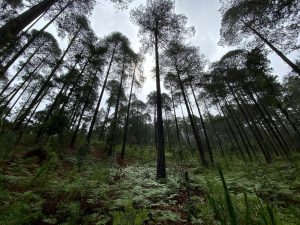
Climate Landscape
Dive into the detailed analysis of the relationship between human activity and climate change in the article Climate Landscape, by Ana Romo and Julio Fonseca.
Climate Change is the main issue on the environmental agenda, perhaps it is also the most urgent planet problem, because despite the pandemic we experienced, scientists continue warning that it is the greatest threat to human health in recorded history.
The impact of human activities on the atmosphere is undeniable. Emissions from various sources, including industrial processes, transportation, and energy production, release a variety of substances. These emissions range from short lived particles such as black carbon that could last for days in the atmosphere to carbon dioxide and chlorofluorocarbons that could last for decades.

Project development.
Photography: Archivo de Yaax Carbon.
In 2020, carbon dioxide concentrations reached an all-time high, rising by 2.57 parts per million (ppm) to reach an alarming 4.14 ppm in December. Carbon dioxide, the main greenhouse gas, leads the charge of global warming, although the potency of methane and nitrous oxide should not be overlooked.
The World Meteorological Organization (WMO) has projected a disturbing scenario: there is a 20% probability that temperature increases will exceed 1.5 °C in 2024, experts recommend not exceeding it in order to avoid devastating climate scenarios.

Durango state project.
Photography: Archivo de Yaax Carbon.
Along with air pollution, deforestation poses an equally important challenge. Deforestation involves the permanent conversion of forests to alternative land uses, such as agriculture, grazing, or urban development.
“The World Meteorological Organization (WMO) has projected a disturbing scenario: there is a 20% probability that temperature increases will exceed 1.5 °C in 2024.”

Development project.
Photography: Archivo de Yaax Carbon.
It is vital to distinguish between deforestation and sustainable logging practices, which allow forests to regenerate naturally or with the help of silvicultural measures. However, when cleared areas are reused for non-forest purposes, the long-term implications could be serious. Loss of forest cover decreases vital carbon sinks, disrupts ecosystems, and accelerates climate change.
The best proven mechanism to date to mitigate emissions is photosynthesis, the process through which trees and plants absorb carbon dioxide and release oxygen. Carbon capture is one of the many benefits that nature provides, we can also name the conservation of biodiversity, water infiltration, temperature regulation, among others.

Development project.
Photography: Archivo de Yaax Carbon
“The best proven mechanism to date to mitigate emissions is photosynthesis, the process through which trees and plants absorb carbon dioxide and release oxygen.”
Mexico is one of the 10 countries with the largest area of primary forests and all known types of natural vegetation recorded. In the international context, it is classified as a forest country because, according to information from the National Forestry Commission, one third of its surface is covered by forests or jungles (65.7 of 197.3 million hectares belong to some type of forest) which shows a very significant potential to quote carbon credits in the international market.
Approximately 80% of the forests and jungles in Mexico are in social ownership, that means that they are ejidos or agrarian communities that could directly benefit from carbon capture projects.

Development project.
Photography: Archivo de Yaax Carbon
At Yaax Carbon, we work on more than 210,000 hectares of forests, jungles, and mangroves, generating carbon credits or also named carbon offsets. Carbon credits are measurable and verifiable emission reductions from certified climate action projects that reduce, remove, or avoid greenhouse gas emissions (GHG).
Carbon offsets also bring a whole host of other positive benefits, for example empowering communities, protecting ecosystems, restoring forests, or reducing dependence on fossil fuels. Our projects have contributed to successfully offsetting more than one million tons of carbon dioxide.

Project development.
Photography: Archivo de Yaax Carbon.
The Forest Carbon Capture Projects that we develop are the product of the efforts of forest communities (mostly of indigenous origin) that through these projects seek the conservation of their forests, jungles, or mangroves. Yaax Carbon measures and quantifies the carbon captured in forests, giving value to the environmental benefits they provide.
Yaax Carbon
Instagram: @yaax_carbon
Facebook: Yaax Carbon
Webpage: www.yaaxcarbon.com











